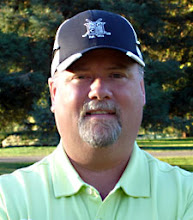Wednesday, September 1, 2010
Green Report-Consistency Part II
Last Monday, the Turf Care Department verticut greens for the first time in a couple of months. This practice uses vertical blades to cut lines in the surface of the green. As this occurs, thatch is removed and sideways growth is reduced to produce a smoother surface. The blades can vary in spacing and depth. Currently, we've set ours at 5/8" apart and a depth of 1/8 inch for a verticut that isn't too aggressive.
Much of the differences between these greens can be attributed to the micro-climates in which they each grow. Micro-climates throughout every golf course complicate management techniques and keep the staff on their toes. Our 4th green sits back in a corner of the golf course that has restricted air movement and poor surrounding drainage. No matter how many times we roll it, this green is usually slower than the others . The higher humidity in this location causes the turf to puff up and slows ball roll. However, just put this little bit of info in the back of your mind and you'll have a slight advantage over visiting competition. Besides the 4th, most other greens roll very close to each other on the stimp meter. Firmness is another matter and this recent verticut aims to combat the variations between greens.
Irrigation is another micro-managed practice to promote consistent playing conditions. Overhead irrigation greatly limits our control of water placement. There has never been a perfect irrigation system unless you count rain, and we won't see that until October. Hand watering is a daily chore and we all know which spots to check on and what percent of moisture each green and turf type needs for the expected high temperature. The task is made simpler with soil probes and moisture meters and each year we reduce wet spots and manage the dry ones.
In golf course management, aerification is the mother of consistency. I know that sounds ridiculous, but I think it's true. Our fall aerification will take place on September 21st and it will be one of the most important days of the year. Out with the bad and in with the good as we remove thatch and open the surface. The "good" is fresh sand, fertilizer, and amendments to improve soil fertility and structure. This day of work will go a long way in maintaining the health of the greens and bring us closer to our goal of consistency.
We micro-manage this process and plan how to attack each green on an individual basis. For Monday's event, we skipped the putting green and double cut #'s 8, 9, 10, 11, 16, 17, 18. The putting green has very little thatch and we would not want to remove what we have because of constant traffic. Thatch is not always a bad thing as it helps to protect and cushion the plant against the weight of golfers and equipment. The other greens listed have more thatch and need to be thinned and smoothed out. Many also have more poa annua, especially 8 and 9. As with any of our work, we are trying to even the playing field and true-up the greens to the same conditions.
Irrigation is another micro-managed practice to promote consistent playing conditions. Overhead irrigation greatly limits our control of water placement. There has never been a perfect irrigation system unless you count rain, and we won't see that until October. Hand watering is a daily chore and we all know which spots to check on and what percent of moisture each green and turf type needs for the expected high temperature. The task is made simpler with soil probes and moisture meters and each year we reduce wet spots and manage the dry ones.
In golf course management, aerification is the mother of consistency. I know that sounds ridiculous, but I think it's true. Our fall aerification will take place on September 21st and it will be one of the most important days of the year. Out with the bad and in with the good as we remove thatch and open the surface. The "good" is fresh sand, fertilizer, and amendments to improve soil fertility and structure. This day of work will go a long way in maintaining the health of the greens and bring us closer to our goal of consistency.
Subscribe to:
Post Comments (Atom)




0 comments:
Post a Comment